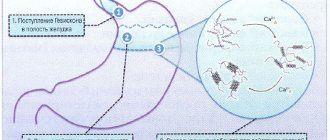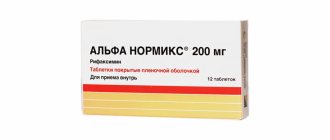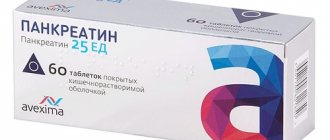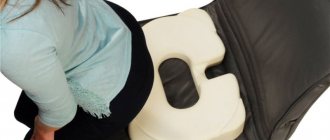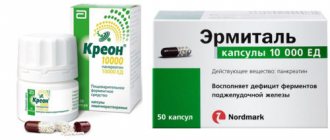Many lactating women suffer from cramping pain. It occurs due to excessive tension in the smooth muscles of the digestive tract, blood vessels, ureters, etc. Acute paroxysmal pain can be relieved with medications. However, nursing mothers are prohibited from taking almost all medications due to the negative impact on the newborn.
Papaverine is an antispasmodic drug that reduces the contractility of smooth muscles and relaxes them. The drug relieves pain of various types. Can Papaverine be taken during lactation? More on this later.
Description of Papaverine
Papaverine is a representative of isoquinoline alkaloids; the drug is created by synthesis. It is produced in 3 dosage forms, which have the following composition:
Pills:
- papaverine;
- sugar;
- starch;
- octadecanoic acid;
- talc.
Liquid for injections:
- papaverine;
- trilon B;
- methionine;
- sterile liquid.
Rectal suppositories:
- papaverine;
- solid fats.
Papaverine reduces the amount of calcium inside cells and relaxes the smooth muscles of the peritoneal organs. Thanks to the action of the active substance, arteries dilate, blood flow improves, and high blood pressure decreases.
At a high dosage, myocardial excitability decreases and chest pain disappears. At the same time, the drug does not depress the activity of the central nervous system, and therefore it can be taken during work related to concentration. In addition, Papaverine does not have a paralytic effect; it relaxes the muscles, maintaining its functionality.
The medication is metabolized in the liver and excreted through the kidneys.
Papaverine is prescribed in the following cases:
- Spasms of smooth muscles of the peritoneal organs (bilious, renal or intestinal colic);
- Spasm of peripheral vessels (endarteritis);
- Cerebral vasospasm;
- Spasm of coronary vessels during angina pectoris and hypertensive crisis (complex therapy);
- Urinary tract spasm;
- Narrowing of the bronchi.
Papaverine is used as an additional drug to enhance the analgesic effect before surgery or diagnostic procedures.
Papaverine
Papaverine
(lat.
papaverine
) - antispasmodic, vasodilator, hypotensive drug. Papaverine is an alkaloid of opium poppy, an isoquinoline derivative. Chemical compound: 1-[(3,4-Dimethoxyphenyl)methyl]-6,7-dimethoxyisoquinoline. The empirical formula is C20H21NO4.
Papaverine is the international nonproprietary name (INN) of the drug. According to the pharmacological index, papaverine belongs to the groups “Vasodilators” and “Myotropic antispasmodics”. According to ATC, papaverine is included in two different groups:
- into the group “A03 Drugs for the treatment of functional gastrointestinal disorders” and has code A03AD01
- into the group “G04 Drugs for the treatment of urological diseases”, subgroup “G04BE Drugs for the treatment of erectile dysfunction” and has the code G04BE02.
“Papaverine”
, in addition, is the trade name of a number of drugs produced in Russia and other republics of the former USSR. Papaverine, registered in the Russian Federation, is available in the form of tablets, suppositories for rectal use, and solution for injection.
Pharmacological action of papaverine
- relaxation of smooth muscles of blood vessels, gastrointestinal tract, respiratory and genitourinary systems reduces blood pressure
- large doses of papaverine reduce the excitability of the heart muscle and slow down intracardiac conduction
- papaverine has a weak effect on the central nervous system; large doses of papaverine have a sedative effect
Indications for use of papaverine
- spasms of smooth muscles of the gastrointestinal tract, including pylorospasm, spastic colitis
- for cholecystitis, renal colic - as part of complex therapy
- spasms of smooth muscles of the genitourinary system
- bronchospasms
- spasms of cerebral and peripheral vessels (endarteritis)
- as an adjuvant for premedication.
Method of use of papaverine and dose
- Inside. Adults: 3–4 times a day, 40–60 mg. The maximum single dose is 400 mg, daily dose is 600 mg.
- Inside. Children: 2 times a day. Single dose: 5 mg for children from 6 months to 2 years, 5-10 mg - from 3 to 4 years, 10 mg - from 5 to 6 years, 10-15 mg - from 7 to 9 years, 15-20 mg - from 10 to 14 years.
- Injections. Subcutaneously and intramuscularly: 1–2 ml (40–60 mg) of a 2% solution 2–4 times a day. Intravenously: slowly 20 mg with a 0.9% sodium hydrochloride solution previously diluted in 10–20 ml.
- Rectally. For adults. 2-3 times a day, 20m40 mg.
Papaverine in comparison with other antispasmodics
Papaverine was isolated from opium by Merck in 1848. It has been produced in industrial quantities since 1930 by Hinoin, Hungary. In 1961, a hydrogenated derivative of papaverine, drotaverine, was created, which received the trade name no-shpa. No-spa is close in chemical structure and mechanism of action to papaverine. Both are phosphodiesterase (PDE) type IV inhibitors and calmodulin antagonists. At the same time, the selectivity of the action of no-shpa in relation to PDE is noticeably greater and the selectivity of its effect on smooth muscles is 5 times higher than that of papaverine. No-shpa is a more effective drug than papaverine, but in Russia papaverine remains a popular medicine, both due to established tradition and low price.
In the treatment of pain of mild and moderate intensity in the abdomen and pelvis, papaverine, along with other antispasmodics (drotaverine, mebeverine, otilonium bromide and others) is a first-stage drug, which, in the absence of a positive effect with monotherapy with antispasmodics and for prolonged and intensifying pain in the abdomen are replaced with second-stage drugs.
Papaverine, although it has a less pronounced antispasmodic effect than no-spa, usually quite effectively relieves acute spasms of various origins. However, in chronic pathologies such as irritable bowel syndrome or biliary tract disorders, oral administration of such drugs in therapeutic doses is often not enough and there is a need to increase their dose or parenteral administration. Although papaverine is usually well tolerated, in large doses or when used intravenously it can cause dizziness, decreased myocardial excitability, impaired intraventricular conduction, and even the development of atrioventricular block. In such a situation, papaverine should be replaced by mebeverine, which has selectivity against the smooth muscles of the digestive tract, mainly the colon, and does not affect the smooth muscle walls of blood vessels.
There are a number of publications in which prominent Russian gastroenterologists express the opinion that in the treatment of gastrointestinal diseases, mebeverine is more effective and has fewer side effects than papaverine and no-spa.
Also, leading Russian gastroenterologists warn that papaverine, like other myogenic antispasmodics, due to their relaxing effect on the lower esophageal sphincter, are not recommended for gastroesophageal reflux disease.
Professional medical articles regarding the use of papaverine in the treatment of the gastrointestinal tract
- Belousova E.A. Antispasmodics in gastroenterology: comparative characteristics and indications for use // Pharmateka. – 2002. – No. 9. – p. 40–46.
- Baranskaya E.K. Abdominal pain: clinical approach to the patient and treatment algorithm. The place of antispasmodic therapy in the treatment of abdominal pain // Farmateka. – 2005. – No. 14 (109).
On the website GastroScan.ru in the “Literature” section there is a subsection “Anspasmolytics”, containing publications for healthcare professionals that address the use of antispasmodics in the treatment of diseases of the gastrointestinal tract.
Contraindications to the use of papaverine
- hypersensitivity to papaverine
- AV block
- glaucoma
- severe liver failure
- elderly age
- children up to 6 months
Cautions when using papaverine
- Papaverine should be administered intravenously slowly and under mandatory medical supervision.
- During treatment with papaverine, it is forbidden to drink alcoholic beverages
- The visodilating effect of papaverine decreases with smoking
- papaverine is prescribed with caution and in small doses after a traumatic brain injury, with chronic renal failure, with hypothyroidism, with adrenal insufficiency, with benign prostatic hyperplasia, with supraventricular tachycardia, with shock.
Due to the lack of necessary clinical data during pregnancy and breastfeeding,
the use of papaverine is possible only with a careful assessment of the benefit-risk ratio. The FDA fetal risk category is N (that is, the drug is not classified by the FDA).
Side effects when using papaverine
Possible side effects:
nausea, constipation, increased transaminase levels in the blood, AV block, ventricular extrasystole, low blood pressure, drowsiness, increased levels of eosinophils in the blood, allergic reactions, sweating, jaundice of the skin and sclera, with intravenous administration - thrombosis (rarely) .
Overdose.
- Symptoms:
double vision, weakness, drowsiness, hypotension. - Treatment:
gastric lavage (milk, activated carbon), maintaining blood pressure. Completely curable with hemodialysis.
Interaction of papaverine with other drugs
- Barbiturates - enhanced antispasmodic effect
- Tricyclic antidepressants, reserpine, quinidine and procainomide - the hypotensive effect of papaverine may be enhanced
- Levopoda - decreased antiparkinsonian effect
- Methylpoda - decreased hypotensive effect
Papaverine and erectile dysfunction
In 1983, the erectogenic effect of papaverine
hydrochloride was discovered when administered intracavernosally into the penis.
The effectiveness of papaverine is up to 40-70%, however, due to the high risk of developing priapism
(prolonged, most often painful erection not associated with sexual arousal), and with long-term use also due to possible progressive sclerosis of the cavernous bodies, modern sexologists do not recommend give injections of papaverine to achieve an erection. At the same time, papaverine, when used as part of complex preparations (alprostadil + papaverine, alprostadil + papaverine + phentolamine) does not produce as many side effects and, in addition, combined preparations increase the effectiveness of action. Before the advent of Viagra (the active substance sildenafil is a selective inhibitor of phosphodiesterase (PDE) type V), intracavernosal therapy was widely used in the treatment of erectile dysfunction, despite its disadvantages: pain at the injection site, fear of an injection into the penis, the possibility of developing ecchymosis (subcutaneous hemorrhages).
Pharmacokinetics of papaverine
- absorption
of papaverine is good, depends on the dosage form - bioavailability
on average 54% - binding to
plasma proteins about 90% - penetration
through histohematic barriers is good - half-life
is approximately 0.5 - 2 hours, but sometimes increases to a day - metabolized
- mainly by the kidneys
Papaverine is an over-the-counter medicine.
Trade names of drugs with the active ingredient “papaverine”
- " Papaverine
", tablets 0.04 g, manufacturers: Irbitsky chemical farm, Moscow pharmaceutical factory, Pharmstandard-Tomskkhimpharm OJSC (Russia), Borisovsky ZMP (Belarus) - " Papaverine
", rectal suppositories, JSC "Biokhimik" (Russia) - " Papaverine
", solution for injection, ampoules of 2 ml, papaverine content 20 mg/ml, JSC "Biosintez", JSC "Biokhimik", JSC Novosibkhimpharm (Russia), Borisovsky ZMP (Belarus) - " Papaverine hydrochloride
", rectal suppositories, JSC "Biosintez", JSC Dalkhimfarm (Russia) - " Papaverine hydrochloride
", solution for injection, ampoules of 2 ml, papaverine content 20 mg/ml, manufacturers: Federal State Unitary Enterprise Armavir Biological Factory, JSC Dalkhimfarm, NPO Microgen, JSC Moskhimfarmpreparaty named after N.A. Semashko (Russia) - " Papaverine MS
", tablets 0.04 g, manufactured by Medisorb CJSC (Russia) - " Papaverine Bufus
", solution for injection, ampoules of 2 ml, papaverine content 20 mg/ml, JSC Update PFK (Russia) - " Papaverine hydrochloride tablets for children 0.01 g
" Borisovsky ZMP (Belarus)
Papaverine as part of drugs with a combined active ingredient
- platiphylline + papaverine, trade names of the drug: platiphylline and papaverine-MEZ tablets
,
platiphylline with papaverine - belladonna leaf extract + papaverine, trade name papaverine hydrochloride 0.02 g, belladonna extract 0.015 g tablets
- bendazole + metamizole sodium + phenobarbital + papaverine, trade name andipal
- bendazole + papaverine + theobromine, trade name theodibaverine
- bromisal + calcium gluconate + caffeine + papaverine + phenobarbital, trade name pagluferal
- nicotinic acid + papaverine, trade name nicoverine
- bendazole + papaverine, trade names papazole, papazole-UFB
Back to section
Dosage
The injection solution is injected into a muscle or vein, the standard dose is no more than 2 ml for one injection. The decision to increase the dosage is made by the attending physician to quickly reduce blood pressure or eliminate severe pain. The next portion of the medicine is administered 4 hours after the first.
The daily dosage of the drug in tablet form is 1 piece three times. The therapeutic course lasts 20 days. If the disease is mild, or the patient’s condition has improved, the dose can be reduced. Papaverine is rarely prescribed for children, and the dose is determined by the attending physician after diagnosis.
If there is a sharp increase in blood pressure, liquid injections are prescribed. In this case, the recommended dosage is 4 ml of solution.
Suppositories are administered rectally (into the anus), the daily dose for adults is 1 piece twice, and for children - 1 piece once.
Papaverine, main action
Papaverine: release form - injection solution
As mentioned above, papaverine is one of the best antispasmodics, which also has anticonvulsant and hypotensive effects. In addition, papaverine has a positive effect:
- During a decrease in muscle tone of the genitourinary system, which can be very dangerous
- Helps reduce muscle tone in the respiratory system
- Promotes vasodilation
- Improves blood flow
- May reduce cardiac excitability
- Has a sedative effect if the drug is prescribed in large doses
Papaverine is very well distributed in the body, affecting absolutely all organs. As for the elimination of the drug, after half an hour the best effect is achieved, and after another short period of time the substance is completely eliminated from the body by the kidneys.
If such a need arises that the remnants of the main active substance must be urgently removed from the body so that it is not in the blood, then it is advisable to carry out dialysis, since only during this procedure the blood is completely cleansed of harmful and unnecessary substances.
special instructions
Papaverine has a number of contraindications:
- Head injuries and recovery period after them;
- Dysfunction of the liver and kidneys as a result of inflammatory diseases;
- Prostate hypertrophy;
- Supraventricular tachycardia;
- Patients under 1 year and after 60 years;
- Hypersensitivity to the main or additional substances.
Use the drug with caution during pregnancy and pregnancy.
For children, minimal doses of medication are prescribed. The antispasmodic should not be used if the child has a serious illness that is accompanied by weakness.
If the dosage is violated, negative phenomena occur:
- hypotension;
- nausea, vomiting;
- dizziness, headache, lethargy, increased sweating;
- increased body temperature;
- nausea, defecation disorders, dry mouth;
- allergies in the form of rash, itching, redness of the skin;
- visual disturbances.
If the patient independently increases the dosage or duration of the therapeutic course, then his vision is impaired, weakness occurs, and blood pressure decreases. If the above symptoms appear, you should stop taking the drug and consult a doctor.
Use of Papaverine during lactation
According to the instructions, Papaverine can be used during breastfeeding only after the doctor’s approval. This is explained by the fact that the drug has not been tested on this category of patients. Therefore, the doctor prescribes a medication if the possible benefit to the mother is higher than the potential danger to the newborn.
To avoid negative effects on the child, it is recommended to switch to artificial formulas during treatment. A lactating woman can ask her doctor to choose a safer medicine.
Thus, Papaverine is allowed to be used by nursing mothers according to doctor's indications, if there are no contraindications.
After taking the drug, it is necessary to monitor the condition of the newborn. A lactating woman must follow the dosage and other doctor’s recommendations regarding taking the drug. Subscribe to our VKontakte group
Indications for use
As mentioned above, papaverine is very widely used during the treatment of various diseases. The main indications for the use of papaverine will be muscle spasms that occur if a person has:
- Endarteritis. This is a disease during which a complete closure of the lumen in the arteries occurs, and as a result, a complete disruption of blood flow, organ damage, and the development of gangrene. This disease mainly affects the vessels of the lower extremities
- Inflammation of the bronchi, in which bronchospasm very often occurs
- Problems with cerebral vessels
- Problems with the abdominal organs, namely renal colic, cholecystitis, colitis
- Angina pectoris. This disease is manifested by severe pain in the chest and behind the sternum, due to the fact that the blood supply to certain areas of the heart is disrupted. The cause of this disorder will be blockage of important vessels or their narrowing
Also, papaverine is used when preparing a person for anesthesia with one purpose, to reduce spasm and muscle tone (mainly the respiratory tract), so that the person can tolerate anesthesia normally. Papaverine has a very good effect on muscles, and this drug has a minimum of side effects, which inspires confidence among patients.




